Some 150 years ago, when American horticulture was still in its infancy Asa Gray of the Arnold Arboretum made note of the similarities of American plants and those of Asia. He speculated that the glacial editing we had in North America and Europe wiped out many specie of plants. Those glaciers did not affect Asia as much. So many Chinese and Japanese plants are begging to be introduced into our American gardens. Many are closely related to our own native American plants and are well adapted to our gardens.
With the cornucopia of plant material we are now introducing, some material is questionable and aside from the investment may well create future problems as we now discover that these “adventuresome” plants have become weeds requiring much labor and or herbicides to remove them from our aging landscape.
Dan Hinkley of the Heron people often used adventurous and other such descriptive s such as “likes to travel”. I don’t know about you, but when I plop a plant into the ground, I expect it to stay put and not to stray. I could buy a dog or cat for that purpose. Look seriously at the ornamental merit of all your plants and avoid those that only create work opportunity for the gardener you hire.
Why do nurseries get away with it? Don’t know, but if I went into an auto supply center and asked for oil and they gave me cheap paraffin: guess what – when the engine seized up I would be ticked off. I feel more people should feel equally protective about their own gardens – or to what they will leave behind.
This is a gardening tale by a Nurseryman who is now eradicating many of the plants he once sold; it might even be termed as a mea culpa or a sermon. The Good, Bad and Ugly of the plant world.” Yes, there are plants I have come to hate. Many are invasive, and often are poisonous plants as well. These plants should come with a warning label.
Consider this lecture as my own warning label. Or as a British man said:” Not all plants belong in the choir of your garden.”) A Sweet William wrote that there was no plant he could not like. It was but a challenge to get to know them better. —To grow closer to them. This not me. I find that there are some plants I really don’t like.
Did you really intend to make your house into a Chia planter? (picture)
Some are based on a weed factor basis, either by stoleniforous adventuring or by spreading by seed. Some commentary is based on foliage impairment.
Houtyinia cordata (Korean Ivy) fits in both categories.
Planting it in a moist border is like inviting the Hell’s Angels to a choir outing!”
As a nurseryman I will also mention the cost factors, both in future labor costs and in the need for chemical use to eradicate plants that ought not to have been planted. Most Nurseries label these plants as “fills in rapidly” or “easy spreader.” Beware of using such invasive plants They may be a quick or CHEAP fix, but your future gardener will have years of labor and work trying to get rid of them.
Did you really intend to make your house into a Chia planter? (picture)
Some are based on a weed factor basis, either by stoleniforous adventuring or by spreading by seed. Some commentary is based on foliage impairment.
Please follow up with your own problem plants. Some of mine include.
Hellebore (aptly named), most Euphorbia, Alstroemaria (the species), Lady’s Mantle, Veronica. Goutweed, Bishop’s weed, some honeysuckles, bittersweet, a native Ginger (Asarum) and so much more. Polygonum, (Knotwed) or sometimes called “Mile-a -Minute.” Anytime the mail-order company lables something as “an adventersome fellow,” beware!
Trees/Shrubs-
Daphne retusa, Stranvaesia davidiana
Beware of using invasive plants for ground covers unless they’re contained by a barrier such as a sidewalk (though such a border won’t stop invasive’s that spread by seed). Mint is notorious for spreading mainly by roots. Put it in a large container, either on your patio or on a pot with feet—not on bare ground. Some notorious, but commonly sold, invasive ground covers and vines include goutweed or bishop’s weed, oriental bittersweet, snow on the mountain, English ivy especially.
No sooner are you thrilled that a certain plant is thriving than it pops up unexpectedly where you didn’t plant it. Then, before you know it. you find that it has aggressively spread its way through your garden. Some reproduce themselves by seed and replant themselves thanks to ants, birds and breezes. (Even slugs!
Others spread aggressively by stolons (stems that creep along the soil surface, taking root wherever. Eventually such stoloniferous plants like asters can choke out or smother their neighbors. Pulling or hoeing them can become a half-year job as stolons left in the ground just re-sprout. The upside to these lovely invaders is that they make good soil binders for slopes and grow where nothing else will. A good example being two lovely native ground covers that I once sold. Vancouverii. Unfortunately, they became so invasive that they wouldl grow through dwarf Azaleas, Mugho Pine and could hardly be pulled out. Imagine my pleasure when I was hired to remove them.
Runaways to watch out for—Illegal immigrants.
Individual states have similar websites. What is noxious in one place may not be a threat elsewhere. Simple matter of weather. David Douglas introduced Salal to Britain, we in return were given Gorst. Plant fanatics are also responsible, finding native vegetation boring we import non local wildflowers. Our Olympic National forests, now have over ninety introduced wildflowers that choke out what we once treasured. Opium poppies being one of them! Which brings me to a few favorites.
Seed-spreaders
Forget-me-nots (Myosotis). these demure little blue flowers refuse to be forgotten, persisting for years as they self-sow. Easy to pull where you don’t want them.
Oxalis (Bermuda Buttercup) Sold in Nurseries and on eBay.
Welsh Poppy. Glorious yellow that fits right in with the above. I have been fighting those for years.
The common Viola (Viola tricolor) or even worse Viola labradorica.This petite flowered member of the viola family so loved relentless reseeds everywhere.
Jupiter’s beard (Centranthus rubra). Self-sows prolifically thanks to small dandelion-like seeds.
Fireweed though beautiful will spread your garden addition to neighbors a mile away. EAT the young plants before they grow!
Helleborus niger (never a weed) but its cousin H. orientalis can be! Same for most of the species.
Helleborus. Not only do their roots suck the nutrition from anything else, unless dead headed their seedlings will overwhelm most gardens.
Linaria purpurea A popular perennial, spreads like crazy. It is on my to kill list wherever I see it.
Same for Lady’s Mantle, five years ago I killed the last plant in someone’s garden. Her seedlings are still coming up. A special thank you to Ann Lovejoy! 🙁
Asarum – Wild gingers especially the N. American variety can throw out thousands of seeds that ants will spread all over your garden.
Veronica spicata and some other species If you love their flowers you will soon be seeing more of them. All over your garden.
Stolon-spreaders:
Most bamboos! Unless you like working with a pickax and pry bar, try not to put them in your garden unless in containers.
(Physostegia virginiana). Obiediant plant it is not. It needs to be root pruned and cut them back all the time. I personally would prefer to do other things in my garden.
Ground cover asters. Hardy, small-flowered types sold simply choke the soil with stolons and send up new shoots everywhere. Curb them with deep six inch plastic edging. Today I pulled out two wheel barrows of them. They are toast. I will spend the entire winter watching the bare soil for new surfacings. This plot will not be plantable until next summer.
(Duchesnea indica). A trailing ground cover with wiry stems that invest small shrubs or small trees.This can be a rampant invader both for the stolons and the berries.
Matilija poppy (Romneya coulteri). A glorious six-foot-tall, gray green stems produce yellow-centered white flowers that resemble fried eggs A good plant on hillsides, keep it on the dry side or contain it like you would bamboo. In an irrigated garden it can surface six feet away from the original planting.
(Oenothera speciosa and others).In a rich environment it can become a pest.
(Vinca major). And Ivies These popular ground covers that root wherever they touch the ground Supposedly a ground cover, I have seen Vinca major choke out choice plants by climbing three feet up their trunks. Ivy of course can make a Chia planter out of your house or garage. In trees they can grow some forty feet high with their vines actually sending root hairs into the bark of the tree.
Sweet woodruff (Galium odoratum). Don’t even get me going on this attractive ground cover. Given a moist garden it can be a major problem.
Gorgeous but heartbreaking. Your runaway plants.
Some are even edible, but even my choppers can’t keep up with runaway mint or Oregano’s—One garden I work in smells like I’m working in an Italian restaurant, so many seedlings have spread all over. Phygelia capenses — African Cape Fuchsia
Physalis franchetti (Chinese lanterns) Nursery’s sell these suckers for 19.95 in five gallon cans never telling the consumer how invasive they can be Lily of the valley. Is another one, wonderful but can get so thick you can barely get a shovel into it.
Rosa witchuriana – A beautiful ground cover rose. But have you ever tried weeding it? Also when it finds vertical support, hint your shrubs – it will climb all over them making pruning an adventure in band-aids and peroxide.
Their could be additional sub-sections to this talk. Laburnums etc.
Poisonous plants that children could eat the fruit of.
Your own Runaway Plants List (Please add your own)
Many of the sedums.Chives and many of the onions. The milky sapped family of Euphorbia. Bishops weed – anything but holy
Plant debris or the problem– what to do with it?
That is just a normal garden, with nothing problematical in it.
However, gardens with Miscanthus and other large plants end up having to dispose of those leaves. One large Miscanthus floridilus would nearly fill my pickup. I shall bring a sample or photo
A special award to those nurseries that still sell Gorse and invasive oxalis! Who doesn’t want a thorny shrub, up to 6 ft. tall, with inch-long spines in their garden? This Western European native was introduced as food plant for sheep and as a “living fence” The minor drawbacks are:
Forms dense, impenetrable thickets that allow nothing else to grow. Seeds can remain viable in the soil for more than 30 years Deep roots help this plant survive fires, and fire helps the seeds sprout. Just the type of plant to survive the new global warming landscape.
I wish to end with a positive note, a poem by Leigh Mercier
To plant a tree is
an act of faith in the earth,
An act of hope for the future
An act of humanity towards
Coming generations
Who will enjoy its fruits
After we shall be gone :
That is the garden and world, I wish to leave behind, and this Thursday’s child has a long way to go on that score.
(C) 2009 and revisited in 2014 Herbert Senft

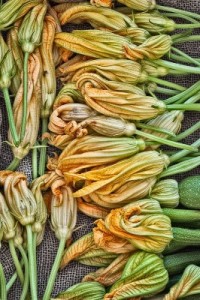
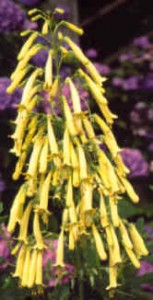

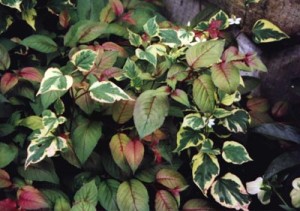
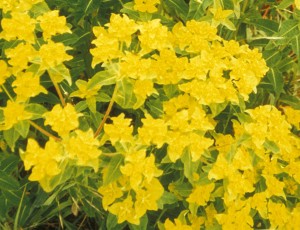
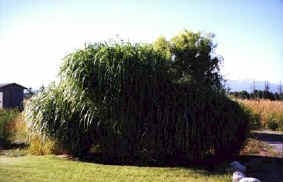
Every new gardener should read this. As an old gardener, I should have known better I am in the digging mode for a large area of rampant lily of the valley(in sun) and vinca. If you have newsletters, please add me to the list. I hope you have a speedy recovery from surgery. Private please- I am zone 5- not sure of zone in Washington state